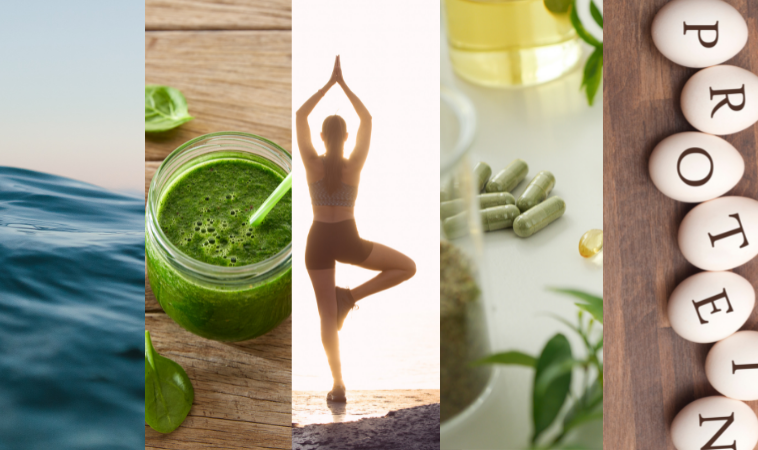It’s well documented that chemicals in our environment accumulate inside our bodies.1 We’re exposed to toxins in air, food, and water, and they enter our bodies before we’re even born. More than 200 chemicals have been found in the cord blood of newborn babies including pesticides, heavy metals, and flame retardants.2 Environmental toxins build up throughout our lives and the older we get, the more toxins we contain.3
Spring cleanses have become a popular way to reduce our toxic burden but protocols vary widely. For some people, cleansing means fasting or following a liquid-only diet. For others it means the elimination of gluten or animal products or processed foods. Merriam-Webster defines “cleanse” as “a very restrictive short-term diet primarily intended to remove toxins from the body.”4 That sounds great, but diet alone can’t remove toxins from the body.
Most environmental toxins are fat-soluble and they’re stored inside fat cells. Removing them requires three steps. First, toxins must be released from their storage sites into the bloodstream. Second, they must travel to the liver where they undergo chemical reactions that transform them into water-soluble compounds the body can excrete. Last, they must be eliminated from the body through the kidneys, bowels, and skin. Diet certainly plays an important part in this process, but true cleansing requires more. Here are five essentials for a safe and effective spring cleanse.
#1 | Water
Drinking plenty of water is essential for cleansing. The more water you drink, the more urine—and water-soluble toxins—your kidneys will eliminate. During a cleanse I recommend taking your weight in pounds and drinking half that number in ounces of filtered water every day. For example, a 150-pound person should drink approximately 75 ounces of water daily while cleansing. This applies to everyone with healthy kidneys. People with kidney disease should not increase their water intake without permission from their doctor and they are not good candidates for a cleanse.
#2 | Protein
The body can’t cleanse with water alone. We also need protein. And because our bodies can’t store it, we have to get it from our diet every day. Whether protein comes from animal foods like eggs or fish, or from plant sources like beans or nuts, it’s broken down into amino acids. The body uses amino acids for lots of important things like energy production, cell growth, tissue repair, and the manufacture of hormones and neurotransmitters. Amino acids are also important for cleansing because they are required for the transformation of fat-soluble toxins the body stores into water-soluble toxins the body excretes.
I recommend eating protein with every meal, especially during a cleanse. A good goal for each meal would be three or more ounces of meat or fish, two or three eggs, six ounces of plain Greek yogurt, one cup of beans, three tablespoons of nut butter or one-half cup of nuts or seeds, especially hemp seeds, pumpkin seeds, peanuts, almonds, and pistachios.
#3 | Fiber
Fiber is essential for cleansing because it promotes elimination. Humans can’t digest fiber, so it passes through the body without being absorbed and adds bulk to the stool. A bulky stool puts pressure on the walls of the intestines, which stimulates the contractions of the smooth muscles that push food through the digestive tract and produce bowel movements. Because toxins are eliminated through the stool, having at least one bowel movement every day is essential during cleansing. If you’re not having daily bowel movements, address this with your doctor before starting a cleanse.
During a cleanse I recommend getting fiber from green vegetables and those that contain prebiotics. Green vegetables are particularly rich in chlorophyll, a compound that reduces the absorption of environmental chemicals and has been shown to facilitate their removal from the body.5 Prebiotics are specific kinds of fiber that stimulate the growth of healthy gut bacteria that help break down toxins. Prebiotics are found in artichokes, asparagus, onions, garlic, beans, and flaxseeds (grind them before you eat them to get the benefits).
#4 | Sweat
Our bodies eliminate toxins through the skin when we sweat. Sweating is our built-in cooling system. If we feel too hot or if our internal temperature rises, our bodies release heat through our sweat glands. We can stimulate sweating by increasing the body’s internal temperature through exercise and sauna therapy. Exercise is essential for a healthy body but it’s particularly important during a cleanse because it increases the circulation of blood and lymphatic fluid throughout the entire body. (The lymphatic system removes waste products and toxins from cells.) Because sweating is so important, I also recommend taking a sauna whenever possible, especially on days of rest.
Sauna therapy uses dry heat to warm the body, increase circulation, and stimulate the elimination of toxins. Traditional saunas heat the room, which heats the body indirectly. Far-infrared saunas use radiant heat and invisible light waves to penetrate tissues, which heats the body directly. Traditional and infrared sauna therapy is usually safe and well tolerated by most people, although many find far-infrared saunas more comfortable because the air temperatures are cooler. Sauna therapy has been contraindicated for people with high blood pressure and heart disease, although some studies show that individuals with these conditions actually benefit from sauna therapy.6 If you’ve been diagnosed with any kind of cardiovascular disease you should get permission from your doctor before taking a sauna. Women who are pregnant, trying to conceive, or breast-feeding should also avoid saunas, along with all kinds of cleansing.
#5 | Nutritional Support
Everything that happens in the body involves chemistry, from the production of energy to the elimination of toxins. Vitamins, minerals, and other nutrients act as necessary cofactors and coenzymes in these chemical reactions. In an ideal world, the nutrients we need for cleansing would come from our diet. But in the real world, it’s almost impossible to get them all from food alone and supplements can compensate for what’s missing. During a cleanse I recommend taking a quality good multivitamin, extra magnesium, extra vitamin C, omega-3 fatty acids, probiotics, and liver-supportive herbs. Before adding any new supplements to your routine, check with your naturopathic doctor about possible interactions and the best dosages for you.
Spring Cleanse Caution
Cleansing isn’t right for everyone. This includes pregnant women, breastfeeding women, individuals who have had recent surgery or chemotherapy treatments, and anyone experiencing constipation, unexplained abdominal pain, kidney disease, liver disease, or inflammation of any part of the gastrointestinal tract. People with serious health problems and those taking prescription medications should talk to their naturopathic doctor before undertaking any kind of cleanse.
Sarah Cimperman, ND is the author of the new book, The Prediabetes Detox: A Whole-Body Program to Balance Your Blood Sugar, Increase Energy, and Reduce Sugar Cravings. She graduated from NCNM in 2002 and has a private practice in New York City. Her expertise has been featured onFox News and Huffington Post and in Natural Health magazine,Whole Living magazine, and the Well Being Journal, among other publications. Dr. Cimperman also writes two blogs, A Different Kind Of Doctor and The Naturopathic Gourmet.
References:
- Centers for Disease Control and Prevention. National report on human exposure to environmental chemicals. [Web page]. CDC website. https://www.cdc.gov/exposurereport/index.html. Accessed March 28, 2022.
- Environmental Working Group. Body burden: the pollution in newborns. [Web page]. EWG website. https://www.ewg.org/research/body-burden-pollution-newborns. Accessed March 28, 2022.
- Hue O, Marcotte J, Berrigan F, Simoneau M, Doré J, et al. Plasma concentration of organochlorine compounds is associated with age and not obesity. Chemosphere. 2007;67(7):1463-7. https://pubmed.ncbi.nlm.nih.gov/17126879/
- Merriam-Webster. Cleanse. [Web page]. MW website. https://www.merriam-webster.com/dictionary/cleanse. Accessed March 28, 2022.
- Morita K, Matsueda T, and Iida T. Effect of green vegetable on digestive tract absorption of polychlorinated dibenzo-p-dioxins and polychlorinated dibenzofurans in rats. Article in Japanese. Fukuoka Igaku Zasshi. 1999;90(5):171–83. https://pubmed.ncbi.nlm.nih.gov/10396873/
- Crinnion W. Sauna as a valuable clinical tool for cardiovascular, autoimmune, toxicant- induced and other chronic health problems. Alternative Medicine Review. 2011;16(3):215-25. https://pubmed.ncbi.nlm.nih.gov/21951023/

















